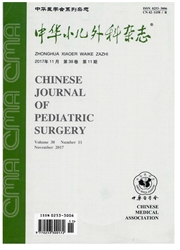

 中文摘要:
中文摘要:
目的利用间歇性缺氧诱导幼年Sprague-Dawley幼鼠,探索建立遗尿模型可行性。方法20d雄性SD鼠24只.体重(45±4.7)g.随机分成间歇性缺氧组和对照组,各12只。实验组行间歇性缺氧4周.对照组暴露于空气.于1、2、3、4周及停止缺氧后1周监测。监测内容:①两组幼鼠清醒和睡眠脑电图;②睡眠遗尿及觉醒功能;③清醒排尿次数及性状。结果①两组幼鼠睡眠期和清醒期脑电图差异明显。无病理性波形出现;②间歇性缺氧组12只幼鼠因觉醒功能障碍,均发生遗尿,缺氧停止.遗尿消失;对照组觉醒功能正常。0例遗尿(P〈0.05):③第3、4周,间歇性缺氧组清醒排尿次数高于对照组(P〈0.(15),有间歇性排尿。结论SD幼鼠间歇性缺氧后因觉醒障碍发生遗尿,且伴有排尿次数增多和间歇性排尿等症状,符合遗尿儿童临床特征。故利用间歇性缺氧诱导SD幼鼠。建立动物模型基本可行。
 英文摘要:
英文摘要:
Objective To establish juvenile rats' enuretic model induced by intermittent hypoxia exposure. Methods Twenty-four male SI) rats (20 days old) with an average weight of 45 ± 2. 7 g were randomly distributed into intermittent hypoxia (IH) group and control group (11 = 12 for each). The IH group was exposed to intermittent hypoxia for 4 weeks; meanwhile, the control group was exposed to air. Electroencephalogram (EEG) and urination frequency under awareness or sleeping status were recorded on the 7 th, 14 th, 21 st. 28 th. 35 th days of the experiment. Results The EEG recorded under awareness was different from that recorded under sleeping status. No pathological wave was recorded under either awareness or sleeping status. Enuresis occurred on 12 IH rats due to arousal re sponse dysfunction. After withdrawing IH, no enuresis reoccurred on these rats. No enuresis was noted in controi group (P〈0. 05). In the 3rd and 4th weeks, urination under awareness of IH group was more frequent than that of control group (P〈0. 05); intermittent urination was also found in IH group. Conclusions Arousal response dysfunction and lower urinary tract symptoms in IH rats are similar with the clinical characteristics of enuretic children.
 同期刊论文项目
同期刊论文项目
 同项目期刊论文
同项目期刊论文
 期刊信息
期刊信息
